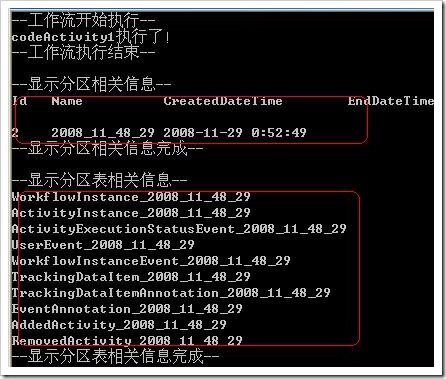相关文章:
WF中的跟踪服务(4):使用跟踪配置文件
WF中的跟踪服务(3):使用SqlTrackingService跟踪规则
WF中的跟踪服务(2):使用SqlTrackingService
WF中的跟踪服务(1):Sql跟踪数据库表,视图,存储过程等相关说明
WF框架中内置的SqlTrackingService服务提供了数据维护的功能,可以将跟踪数据库中的信息移动到指定的分区中。利用该功能我们可以有效的管理这些不断增长的跟踪数据,使得维护和数据的分析更容易。
分区方案
WF 提供两种分区的方案,自动和手动两种方式。默认情况下SqlTrackingService 的分区功能是没有启用的,要想启用需要将SqlTrackingService 的PartitionOnCompletion 属性设置为 true,如果启用了分区,则会为跟踪数据定期创建一组新的表,以便能够将旧数据存档并将其从主数据库中删除,而不会影响当前运行的应用程序。 在启用分区的情况下,将仍然在原始表中创建跟踪数据,但随后当工作流完成时,这些数据将被移到分区表中。
1.自动的方式
该方式不会影响应用程序的正常运行。 分区是在每个工作流实例完成时执行的。 由于跟踪工作流实例而生成的记录会添加到常规跟踪表中,直到工作流实例完成。 届时,这些记录会移至分区表中。 当启用了分区时,会定期为跟踪数据创建一组新的表。 已完成的工作流实例的跟踪数据会移至这些新的分区中,同时不会中断当前正在运行的应用程序。默认的间隔是每月的,如果你要改变你就使用SetPartitionInterval存储过程。该存储过程接收一个单独的参数表示新的间隔,d(daily),w(weekly),m(monthly),and y(yearly)这几个值。该值存储在TrackingPartitionInterval表中。表 vw_TrackingPartitionSetName 包含有关分区集名称的信息,包括 Name 、CreatedDateTime、EndDateTime 以及 PartitionInterval。
2.手动的方式
手动的方式是在应用程序停止的时候进行的,使用PartitionCompletedWorkflowInstances 存储过程将工作流实例从实时表中插入的跟踪数据移到分区表中。这两种方式各有优缺点。 自动的会影响性能,特别是数据量很大的时候。 如果你不想有性能的损失,就手动做,默认情况PartitonOnCompletion属性就是false的,一般在你停机时候来做分区。
移除分区
当你不再需要这个分区的时候,你有两种选择,一种是分离,一种是删除。使用DetachPartiton存储过程,就逻辑上从标准的视图中移除了分区。实际上内部执行的是RebulidPartitonViews存储过程来更新视图。就是说当你分离这些分区的时候,这些表并没有删除。使用DropPartiton存储过程物理上删除表。这两个存储过程都接收一个分区名称和分区id,你可以通过查询vw_TrackingPartitonSetName来得到这些值。
实例分析
1.我们将相关的操作封装一个类SqlDataMaintenanceHelper,代码如下:
public class SqlDataMaintenanceHelper { public const string strConn = "Initial Catalog=WorkflowTracking;Data Source=localhost; Integrated Security=SSPI;"; //设置分区时间周期 public static void SetPartitionInterval(char interval) { try { using (SqlConnection conn = new SqlConnection(strConn)) { SqlCommand command = new SqlCommand("SetPartitionInterval", conn); command.CommandType = CommandType.StoredProcedure; command.Parameters.Add( new SqlParameter("@Interval", interval)); command.Connection.Open(); command.ExecuteNonQuery(); } } catch (SqlException e) { Console.WriteLine("SqlException in SetPartitionInterval: {0}", e.Message); } } //删除分区 public static void DropPartition(Int32 partitionId) { try { using (SqlConnection conn = new SqlConnection(strConn)) { SqlCommand command= new SqlCommand("DropPartition", conn); command.CommandType = CommandType.StoredProcedure; command.Parameters.Add(new SqlParameter("@PartitionName", null)); command.Parameters.Add(new SqlParameter("@PartitionId", partitionId)); command.Connection.Open(); command.ExecuteNonQuery(); } Console.WriteLine("Partition {0} dropped", partitionId); } catch (SqlException e) { Console.WriteLine("SqlException in DropPartition: {0}", e.Message); } } public static void DetachPartition(Int32 partitionId) { try { using (SqlConnection conn = new SqlConnection(strConn)) { SqlCommand command = new SqlCommand("DetachPartition", conn); command.CommandType = CommandType.StoredProcedure; command.Parameters.Add(new SqlParameter("@PartitionName", null)); command.Parameters.Add(new SqlParameter("@PartitionId", partitionId)); command.Connection.Open(); command.ExecuteNonQuery(); } Console.WriteLine("Partition {0} dropped", partitionId); } catch (SqlException e) { Console.WriteLine("SqlException in DropPartition: {0}", e.Message); } } //手动执行分区 public static void PartitionCompletedInstances() { try { using (SqlConnection conn= new SqlConnection(strConn)) { SqlCommand command = new SqlCommand("PartitionCompletedWorkflowInstances", conn); command.CommandType = CommandType.StoredProcedure; command.Connection.Open(); command.ExecuteNonQuery(); } Console.WriteLine("Partitioning of workflows completed"); } catch (SqlException e) { Console.WriteLine("SqlException in PartitionCompletedInstances: {0}", e.Message); } } //显示分区信息 public static void ShowAllPartitions() { try { using (SqlConnection conn= new SqlConnection(strConn)) { SqlCommand command = new SqlCommand(@"SELECT * from vw_TrackingPartitionSetName ORDER BY PartitionId", conn); command.Connection.Open(); Console.WriteLine("--显示分区相关信息--"); Console.WriteLine("{0,-4} {1,-13} {2,-22} {3,-20} {4,-4}", "Id", "Name", "CreatedDateTime", "EndDateTime", "PartitionInterval"); using (SqlDataReader reader = command.ExecuteReader()) { while (reader.Read()) { Console.WriteLine("{0,-4} {1,-13} {2,-22} {3,-20} {4,-4}", reader["PartitionId"], reader["Name"], reader["CreatedDateTime"], reader["EndDateTime"], reader["PartitionInterval"]); } reader.Close(); } Console.WriteLine("--显示分区相关信息完成--"); Console.WriteLine(); } } catch (SqlException e) { Console.WriteLine("SqlException in DisplayAllPartitions: {0}", e.Message); } } //显示分区表信息 public static void ShowPartitionTableInfo() { try { using (SqlConnection conn = new SqlConnection(strConn)) { SqlCommand command = new SqlCommand("declare @trackingName varchar(255) select @trackingName = Name from TrackingPartitionSetName " +"select name from sysobjects where name like '%' + @trackingName", conn); command.Connection.Open(); Console.WriteLine("--显示分区表相关信息--"); using (SqlDataReader reader = command.ExecuteReader()) { while (reader.Read()) { Console.WriteLine(reader[0]); } reader.Close(); } Console.WriteLine("--显示分区表相关信息完成--"); Console.WriteLine(); } } catch (SqlException e) { Console.WriteLine("SqlException in ShowPartitionTableInformation: {0}", e.Message); } } } 2.我们建立一个最简单的工作流,只放一个CodeActivity,宿主程序中我们加载SqlTrackingService服务,
并使用上面的类来显示相关信息,代码如下:
class Program { static void Main(string[] args) { using(WorkflowRuntime workflowRuntime = new WorkflowRuntime()) { SqlTrackingService sts = new SqlTrackingService(SqlDataMaintenanceHelper.strConn); sts.PartitionOnCompletion = false; SqlDataMaintenanceHelper.SetPartitionInterval('d'); workflowRuntime.AddService(sts); AutoResetEvent waitHandle = new AutoResetEvent(false); workflowRuntime.WorkflowCompleted += delegate(object sender,
WorkflowCompletedEventArgs e){waitHandle.Set();}; workflowRuntime.WorkflowTerminated += delegate(object sender,
WorkflowTerminatedEventArgs e) { Console.WriteLine(e.Exception.Message); waitHandle.Set(); }; WorkflowInstance instance = workflowRuntime.CreateWorkflow(typeof
(CaryDataMTDemo.Workflow1)); Console.WriteLine("--工作流开始执行--"); instance.Start(); waitHandle.WaitOne(); Console.WriteLine("--工作流执行结束--"); Console.WriteLine(); SqlDataMaintenanceHelper.ShowAllPartitions(); SqlDataMaintenanceHelper.ShowPartitionTableInfo(); } } }
3.程序执行的结果如下:
我们可以看看数据库中表和视图的变化,如下图:
4.如果你删除当前的分区时,会报下面的错误:
SqlException in DropPartition: DetachPartition 失败 - 分区正处于 Activity 状态或处于翻转期。
这是因为你不能使当前分区处于非活动状态,因为如果可以的话,你就没有办法在工作流实例完成的时候将跟踪数据转移到分区中了。你只能分离或删除非活动的分区。当分区的间隔过期后就会产生新的分区,这个时候新的分区就成为了活动分区,原来的就变为非活动分区,这个时候就可以删除了。







【推荐】国内首个AI IDE,深度理解中文开发场景,立即下载体验Trae
【推荐】编程新体验,更懂你的AI,立即体验豆包MarsCode编程助手
【推荐】抖音旗下AI助手豆包,你的智能百科全书,全免费不限次数
【推荐】轻量又高性能的 SSH 工具 IShell:AI 加持,快人一步
· 如何编写易于单元测试的代码
· 10年+ .NET Coder 心语,封装的思维:从隐藏、稳定开始理解其本质意义
· .NET Core 中如何实现缓存的预热?
· 从 HTTP 原因短语缺失研究 HTTP/2 和 HTTP/3 的设计差异
· AI与.NET技术实操系列:向量存储与相似性搜索在 .NET 中的实现
· 周边上新:园子的第一款马克杯温暖上架
· Open-Sora 2.0 重磅开源!
· .NET周刊【3月第1期 2025-03-02】
· 分享 3 个 .NET 开源的文件压缩处理库,助力快速实现文件压缩解压功能!
· Ollama——大语言模型本地部署的极速利器